For many years, X-rays have been the major imaging technique for evaluation of the foot, for both diagnosis and, more recently, as a screening procedure as part of a pre-purchase examination.
However, new imaging techniques such as scintigraphy (bone scanning), ultrasound and magnetic resonance imaging (MRI) have enhanced our knowledge of problems that can cause foot pain and lameness.
So how useful are X-rays, either for diagnostic purposes in a lame horse or as a predictor of future soundness? What do they tell us?
X-rays enable us to see the bones of the foot, but provide only limited information about the soft tissues. With severe deep digital flexor tendon damage, there may be either mineralisation within the tendon that can be seen on X-rays, or new bone at the tendon’s attachment to the pedal bone. With severe damage to collateral (supporting) ligaments of the coffin joint, a cyst-like area may develop in either the pedal bone or, less commonly, the short pastern bone, which can be seen on X-rays. However, with milder injuries of either of these structures, X-rays may be completely normal.
The anatomy of the foot is complex and the bones that can be seen on X-rays represent only a small proportion of the anatomical structures. Moreover, there must be at least a 40% change in bone structure before abnormalities can be seen on an X-ray. If an area of damage is deep within the bone it may be obscured by normal bone on either side.
Bones are three-dimensional structures, but X-rays give two-dimensional images. It is therefore crucial to obtain images from a variety of different views.
Mud on the foot or the presence of a shoe will result in shadows on an X-ray that confuse interpretation or obscure part of the bones, and can potentially hide abnormalities. Packing the foot with a substance such as Playdoh can reduce confusing shadows.
There is no doubt X-rays can provide crucial information provided they are high quality and that a sufficient number of different views have been obtained. In most circumstances, the shoe should be removed, so that no part of the bones is obscured. This will also facilitate proper cleaning of the foot.
There is also little doubt that advances in technology mean digital or computerised radiography can enhance the diagnostic capabilities of X-rays, provided such sophisticated systems are used in the best possible way. Badly used systems will produce bad X-rays, offering no advantage over conventional techniques. In fact, poor quality digital X-ray images, saved as jpeg files and sent via e-mail, may provide much less information than conventional X-rays.
Top-quality X-rays still have a major role to play in lameness diagnosis, despite their limitations. In a lame horse, ultrasound, scintigraphy or MRI may provide valuable complementary information.



